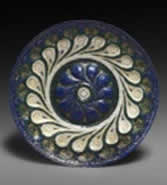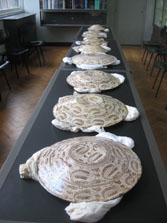Who would imagine that a simple piece of earthenware can speak volumes about the economy, science, fashion, and political upheavals of Renaissance Spain? Tanja Tolar peels back these layers of meaning as she looks at a dish in The Courtauld Gallery’s collection, made between 1500–25.
Work on this project was carried out by Tanja during her PhD in the History of Art and Archaeology at the School of Oriental and African Studies (SOAS), University of London.
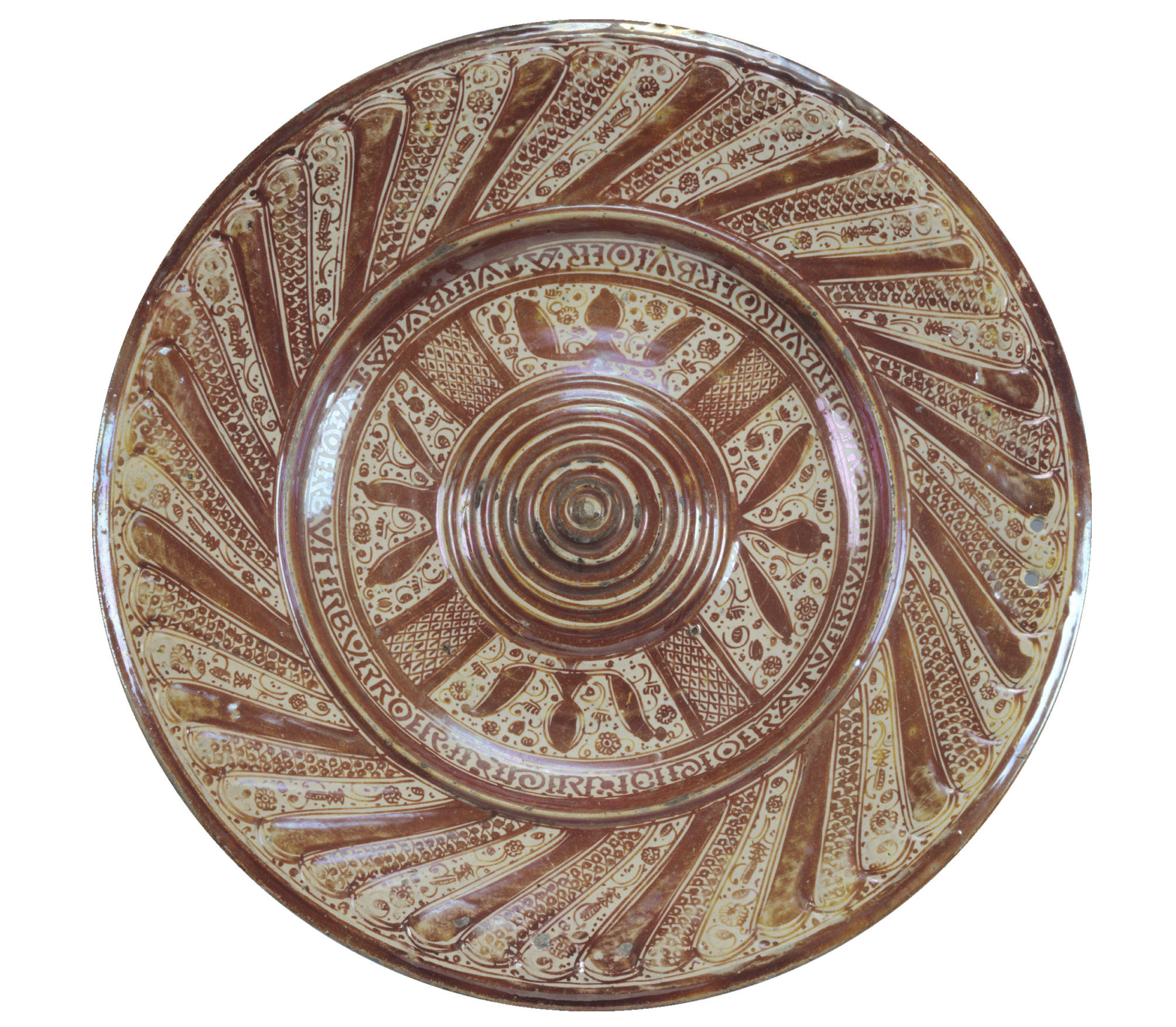
Spanish Ceramics: Craftsmanship in Context
Likely from Manises, near Valencia, this dish is a product of the large-scale manufacture of lustred ceramics in the region, which exported its wares all over Europe between about 1400 and 1600. Spanish lustreware has a dual heritage, reflecting the Islamic and Christian history of the Iberian Peninsula: while the shape of this dish is European, the monochrome (one-colour) lustre and other elements recall the earlier ceramics of Islamic Spain.
During this golden age of earthenware production, lustreware was one of Spain’s most sought-after and exported luxury commodities. The economic success of this industry was due in large part to the continuous employment of Muslim potters even after the Reconquest in 1492. Muslims living in Spain under Christian rule were known as Mudéjars. They continued to work within the decorative traditions of Muslim Spain, and were responsible for the transmission of lustreware knowledge, as this highly specialised craft was learned through first-hand experience, and passed on from one generation of potters to the next.

The small town of Manises was for many years the most important centre in the region of Valencia. It enjoyed thriving trade, and through its proximity to the international port of Barcelona, was able to export its wares all over Europe.
The production of lustreware was costly because it was technically very difficult to achieve and the ingredients were expensive, especially the silver for the lustre and the imported tin for the creamy white glaze. Although it was a luxury industry, many of the wares thought to have been made during the 16th century show firing accidents, smudges, fingerprints and distorted handles.
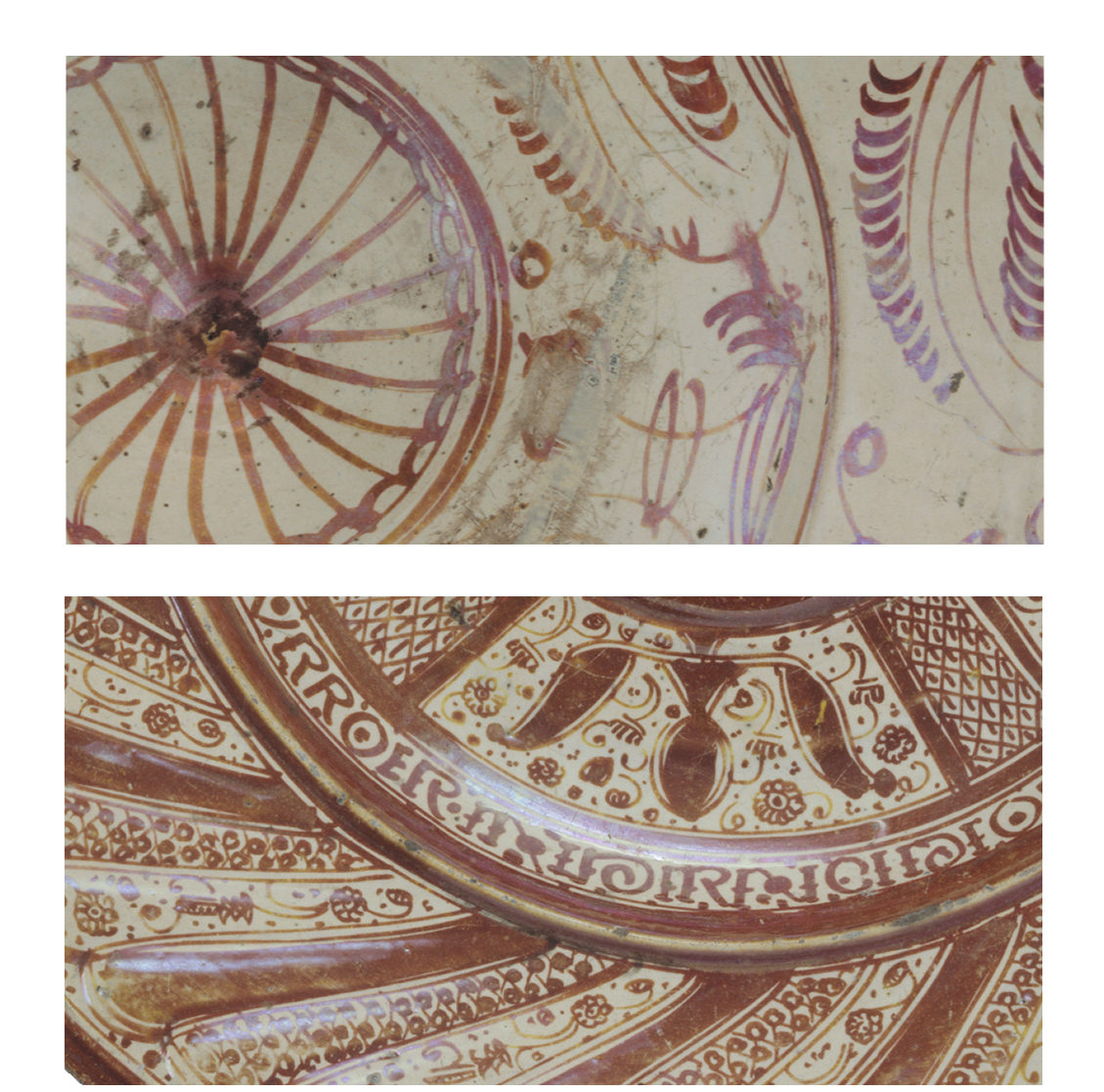
Other recurring imperfections, such as the misalignment of painted and moulded decoration suggest the speed with which painters worked to meet orders. This flaw is particularly noticeable on the gadrooning — the fluted border — around the object. The presence of so many mistakes might also suggest a drive for quantity over quality. Perhaps the international clients of Spanish lustreware wished to wow their visitors with the impression of luxury, achieved by the display of a huge array of wares, rather than the exquisite quality of individual pieces.
Spanish lustreware is extremely difficult to date because of the continuity of its designs. This continuity led to the invention of the expression ‘Hispano-Moresque ware’ in the nineteenth century. This terminology has recently been replaced by the more neutral ‘Spanish lustreware’, which describes the genre technically and situates it geographically, while at the same time distinguishing it from the earlier lustreware of Islamic Spain.
Italy was the most avid importer of Spanish lustreware. By the time this dish was made, potters located in the Umbrian towns of Gubbio and Deruta had perfected their own version of lustreware. Their popular product imitated the look of Spanish lustre, although the colours were quite different.
As interest in acquiring Italian lustred ceramics rose, Valencian lustreware became less desirable abroad and there was a sharp decline in exports. The region did, however, continue to produce its traditional lustreware, for a domestic market at least, well into the 18th century.
Design and Decoration
The design and decoration of Valencian lustreware reflect the region’s complex Islamic and Christian history. Much of the lustred decoration, like the technique itself, recalls the earlier Islamic ceramics of Spain, while the shape of many of the wares is European. Large dishes like these (this one measures 47.5cm in diameter) were made almost on an a mass scale. Decorative motifs are fairly standard, consisting of stylised plants, geometrical ornamentation, and often animals and coats of arms. True coats of arms are an important aid in the dating of pieces but many are untraceable or purely aesthetic.
The gadrooned pattern around the edge of this dish is one of the most frequently recurring moulded designs on Spanish lustreware of the period. Two further examples, seen below, are at the Victoria & Albert Museum in London. The shape is not indigenous to Spain and is commonly found in Italian and wider European metalwork contemporary to our object. It was likely introduced to the potters in Spain by the Italian merchants who exported these wares to clients across Europe.
The dish has two holes near the rim. Careful looking reveals that the tin glaze which covers the object’s surface runs down into the holes. From this detail, we can surmise that the holes were made before firing. All Spanish lustreware dishes have one or two holes, indicating that they were suspended, either for storage or display. It is likely that once exported to Italy, the holes may have become redundant, owing to the frequent display or earthenware on a stepped piece of furniture, or credenza.
Around the well of the dish is an inscription in Latin, referring to the first line of the Gospel of Saint John: ‘IN PRINCIPIO ERAT VERBUM’ (‘In the Beginning was the Word’). The phrase makes a striking decorative addition to the dish, evoking the piece’s Christian patronage and Islamic heritage. Calligraphic inscriptions are an important legacy of the artistic traditions of Islamic Spain. Although the spelling here is faulty, the inscription is complete and legible. Many similarly positioned inscriptions are much more difficult to decipher, with some lustreware bearing inscriptions that are decorative and devoid of meaning.
As with all Valencian dishes, the reverse is freely painted in lustre, here in a simplified floral design. It would seem that the dishes were designed to be appreciated from both sides.
Lustre Technology
Lustre technology was developed in the Middle East around the 9th century and flourished in the Islamic world. As we have seen, the tradition was maintained in Spain under Islamic and then Christian rule, largely thanks to the continued presence of Muslim potters and the desirability of these wares throughout Europe.
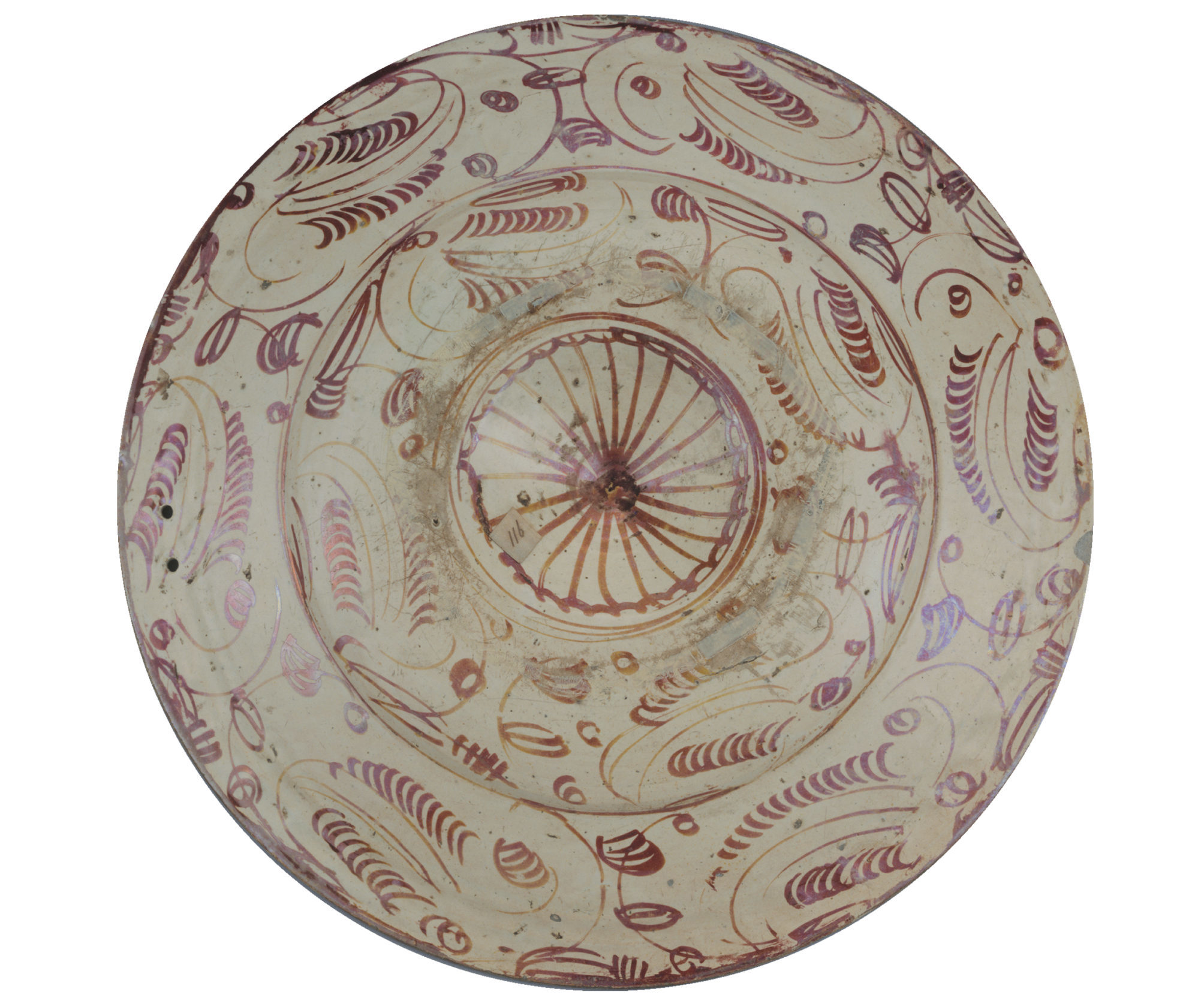
A painterly technique, lustre involves the application of compounds of copper and silver, mixed with clay or ochre, to an already fired and glazed ceramic object. After the lustre has been applied, the vessel is then fired again at lower temperatures in a smaller kiln than the one used initially. Firing in this special, oxygen-reduced, kiln enables the metallic compounds to bond to the surface of the glaze. Recent scientific analysis has shown this metallic layer to be extremely thin, at 0.2 microns (or 0.0002 mm). The result is a metallic sheen resembling precious objects in gold and silver, which only reveals its full irridescence in optimum lighting conditions.
The colour and opacity of Spanish lustreware glazes depends on the quantity of tin used in their preparation. The more tin they contain, the whiter and more opaque the glaze. Tin was expensive, as it had to be imported from southwest England. Over time, potters began to economise and make their glazes with less tin, resulting in the clay-coloured tones that are in evidence on The Courtauld’s dish.
The colour of lustre depends on the exact combination of the metallic oxides and the temperature in the kiln, among other variables. Lustre with a higher silver content creates a subtle golden sheen, whereas lustre with a higher copper content is reddish brown. In the 15th century, the heyday of Valencian lustreware production, hues tended toward yellow or amber gold. This tone modulated to orange-gold, eventually becoming browner and redder in the 16–17th centuries and beyond. Recent technical analyses of lustreware compositions have noted that the redder appearance of later lustres (of the 17th and 18th centuries) arose from a more liberal use of copper, with silver content remaining at similar levels to those of the past. This discovery makes a marked departure from previous studies, which proposed that the red tones were due to potters economising, using their silver sparingly. And so, the conventional thinking about later wares, which attributed the change in colour to financial considerations, might make way for an understanding based on evolving tastes. In short, it would seem that redder tones became increasingly in vogue.

